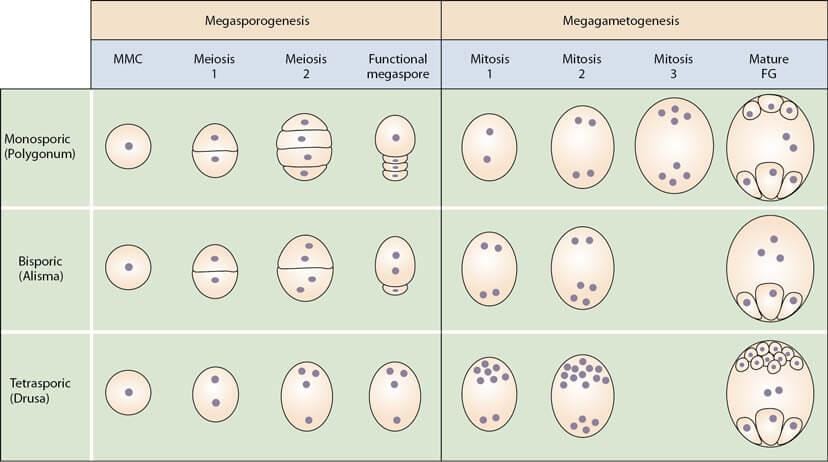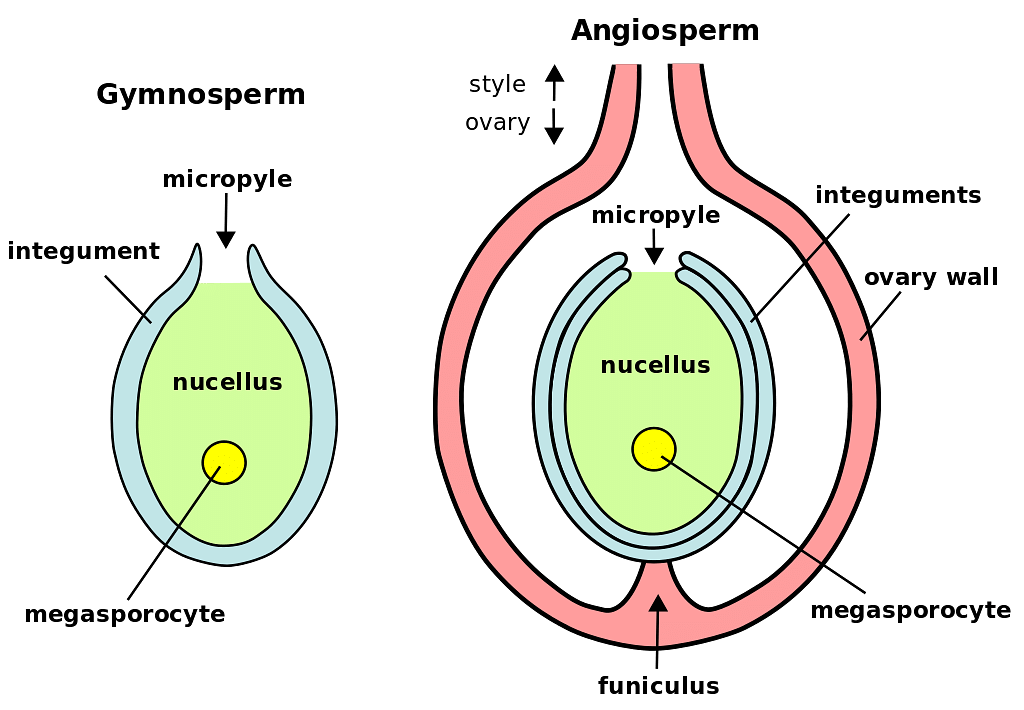Grade 12 Exam > Grade 12 Notes > Biology for Grade 12 > Megasporogenesis & Megagametogenesis
Megasporogenesis & Megagametogenesis | Biology for Grade 12 PDF Download
Megasporogenesis
- During the development of the ovule, at the beginning of this process, the nucleus develops from the placenta in the form of a small rounded outgrowth like structure.
- At this stage, all the cells of the nucleus are undifferentiated, homogeneous and meristematic. This mass of cells surrounded by a single-celled thick layer of the epidermis.
 Plant ovules with megasporocytes before meiosis: Gymnosperm ovule on left & Angiosperm ovule (inside ovary) on right
Plant ovules with megasporocytes before meiosis: Gymnosperm ovule on left & Angiosperm ovule (inside ovary) on right - Any one hypodermal cell of the nucleus is differentiated and increase in size. It becomes different from the rest of the cells due to the presence of a distinct nucleus. It is called an archesporial cell.
- Archesporium divides periclinally to form an outer primary parietal cell and inner Primary Sporogenous cell. The activity of the Primary Parietal cell depends on the type of plants.
- If the plant belongs to gamopetalae then it forms a tenuinucellate type ovule and if the plant belongs to polypetalae then it forms crassinucellate type of ovule. The primary sporogenous cell directly acts as a megaspore mother cell.
- It divides meiotically to form, four haploid megaspores. The four haploid megaspores generally arranged in a linear tetrad. Generally, the lowermost or chalazal megaspore remains functional out of tetrad of megaspores and the other three lie towards the micropyle degenerate.
- This functional megaspore produces female gametophyte. In most Angiosperms [Capsella], the Chalazal megaspore remains functional.
Development of Embryosac or Female Gametophyte (Megagametogenesis)
- The megaspore is the first cell of the female gametophyte. This megaspore grows in size and obtains nutrition from the nucleus. The nucleus of the megaspore divides mitotically to form two nuclei.
- Each nucleus moves towards the opposite pole and reached at their respective poles. Both the nuclei lie at poles divide twice mitotically. Resulting, four-four nuclei are formed at each pole (Total 8-nuclei).

Development of Female Gametophyte
- Out of the four, one-one nucleus migrates from both poles (one nucleus from the chalazal side and one nucleus from the micropylar side) towards the centre. They are known as polar nuclei. Both polar nuclei are present in the centre.
- The remaining three-three nuclei at each pole surrounded by cytoplasm to form cells as a result of cytokinesis. Three cells are formed towards the micropyle in which one cell is large and more distinct out of three cells. This is called the egg cell and the remaining two smaller cells are known as synergids.
- These three micropylar cells are collectively known as egg-apparatus (1 Egg cell + 2 Synergids). The three cells are formed toward the Chalaza are called antipodal cells. Both the polar nuclei present in the central cell. But just before the process of fertilization they unite or fuse together in the centre to form the secondary nucleus. It is diploid in nature (2n) and one in number.
Question for Megasporogenesis & MegagametogenesisTry yourself:An egg-apparatus contains
View Solution
- Therefore, seven cells and eight nucleated structure is formed. This eight nucleated and seven celled structure is called the female gametophyte or embryo sac of Angiosperms. This type of embryo sac is known as the "polygonum type" because it is discovered by Strasburger in the Polygonum plant.
- Polygonum type embryo sac is the most common type in Angiosperms (Capsella). Polygonum type of embryo sac develops from single megaspore so it is also known as monosporic embryo sac.
- Fingers like processes are produced from the outer wall of the synergids are known as filiform apparatus. With the help of these structures, synergids absorb food from the nucleus and transfer it to the embryo sac. Filiform apparatus is less developed in antipodal cells. Filiform also secrete chemicals that attract the pollen tube.
Question for Megasporogenesis & MegagametogenesisTry yourself:The normal or polygonum type of embryo sac is
View Solution
➢ Types of Embryo Sacs
 Monosporic, Bisporic and Tetrasporic Embryo Sac
Monosporic, Bisporic and Tetrasporic Embryo Sac
- Monosporic Embryo sac
It is of two types:
(i) Polygonum type: It is an eight nucleated and seven celled embryo sac.
(ii) Oenothera type: Exceptionally it is four nucleated in which only one nucleus in a central cell and three nuclei in the egg apparatus. Antipodal cells are absent. Endosperm will become diploid. Micropylar megaspore becomes functional. - Bisporic Embryo sac
It is formed by two megaspores. It means it develops from two nucleated megaspores.
It is of three types:
(i) Allium type: Eight nucleated and seven celled Chalazal megaspores.
(ii) Endymion type: Eight nucleated and seven celled Micropylar megaspores.
(iii) Tetrasporic type: It is formed by all four megaspore nuclei because meiosis is not accompanied by Cytokinesis so that four nuclei of megaspores are formed. All four nuclei are collectively known as "Coeno-megaspore".
Generally, all the four Nuclei of megaspores take part in the formation of the seven celled and eight nucleated embryo sac.
Old Syllabus NCERT
➢ Some other Types of Embryo Sacs
- Beside the above types of embryo sac, different other types of embryo sacs are also formed. Arrangement of nuclei are not definite in embryo sac in some Angiosperms.
- So, that different type of embryo sacs are formed as follows:

The document Megasporogenesis & Megagametogenesis | Biology for Grade 12 is a part of the Grade 12 Course Biology for Grade 12.
All you need of Grade 12 at this link: Grade 12
|
124 videos|210 docs|207 tests
|
FAQs on Megasporogenesis & Megagametogenesis - Biology for Grade 12
| 1. What is megasporogenesis? |  |
Ans. Megasporogenesis is the process of formation and development of megaspores within the ovule of a plant. It occurs in the ovule's megasporangium, where a diploid megasporocyte undergoes meiosis to produce four haploid megaspores. Only one of these megaspores survives and develops further into the female gametophyte.
| 2. How does megagametogenesis occur? |  |
Ans. Megagametogenesis, also known as the development of the embryosac or female gametophyte, is a process that takes place within the ovule of a plant. After megasporogenesis, the surviving megaspore undergoes mitotic divisions to give rise to a multicellular structure called the embryosac. The embryosac contains the female gametes, including the egg cell, synergids, and antipodal cells, which are essential for the fertilization process.
| 3. What is the role of megasporogenesis and megagametogenesis in plant reproduction? |  |
Ans. Megasporogenesis and megagametogenesis are crucial processes in plant reproduction. Megasporogenesis produces megaspores, which eventually develop into the female gametophyte or embryosac. The female gametophyte contains the reproductive cells necessary for fertilization. During pollination, the male gametes from the pollen tube enter the female gametophyte and fertilize the egg cell, leading to the formation of a zygote and subsequent embryo development.
| 4. How do megasporogenesis and megagametogenesis contribute to genetic diversity in plants? |  |
Ans. Megasporogenesis and megagametogenesis contribute to genetic diversity in plants through the process of sexual reproduction. During megasporogenesis, meiosis occurs, leading to the formation of genetically diverse megaspores. Only one of these megaspores develops into the female gametophyte, further increasing genetic variation. Additionally, during fertilization, the fusion of male and female gametes results in the combination of genetic material from two different individuals, leading to further genetic diversity in the offspring.
| 5. What environmental factors can influence megasporogenesis and megagametogenesis? |  |
Ans. Several environmental factors can influence megasporogenesis and megagametogenesis in plants. Temperature, light intensity, and humidity are some of the key factors that can affect the timing and success of these processes. Stress conditions, such as drought or extreme temperatures, can disrupt the normal development of megaspores and female gametophytes. Pollination and the presence of compatible pollen grains are also crucial for successful fertilization and embryo development.
Related Searches

























